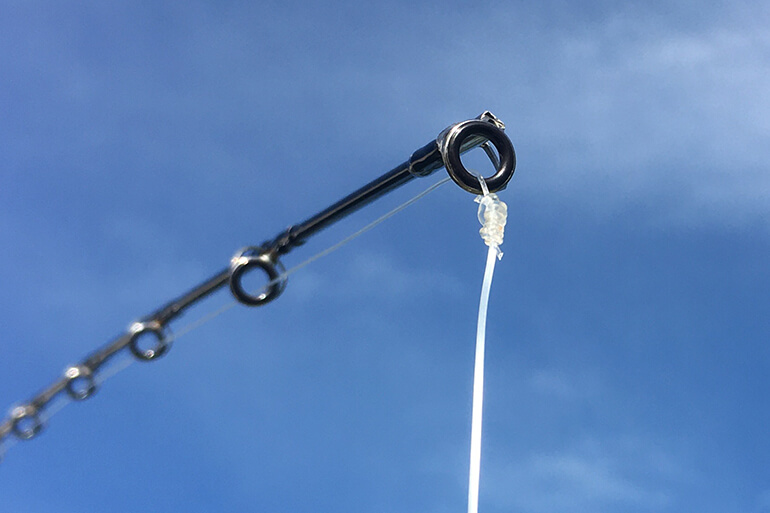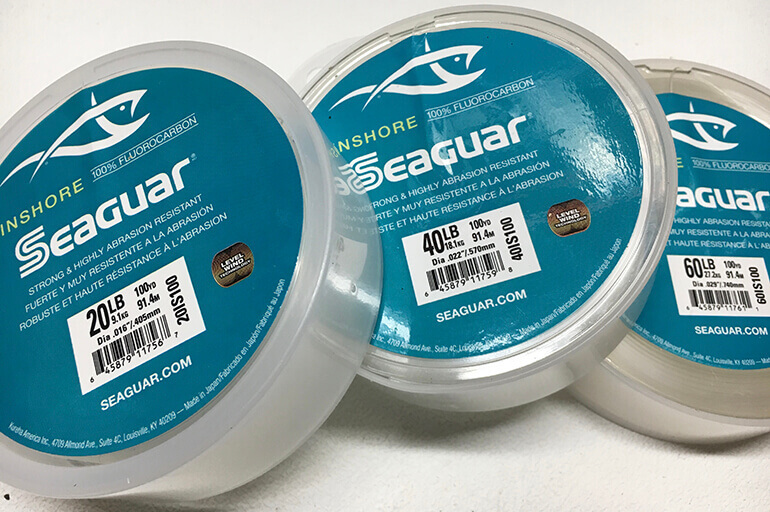What Pound Test of Braided Line Tied to What Pound Test of Fluorocarbon Leader
How Best To Tie Your Leaders: You Might Be Doing Information technology Incorrect
Multi-stage leaders optimize stealth, lure action and abrasion resistance

February 24, 2021
The h2o was articulate and the bites few and far between. I did what any fisherman would do—I downsized my leader. I figured 20-pound-exam fluorocarbon would assist close the deal with the side by side redfish that happened by.
The next redfish turned out to be a 4-human foot tarpon which bolted from the mangroves, ate my jig, erupted next to my kayak and raked its cheese-graters across my gossamer leader. Gone.
I knew the risks. When y'all "go lite to get the seize with teeth," y'all take your chances. Actually, it was laziness on my office. Usually I prepare my leaders for such encounters. I like to stop my leaders with a short department of heavier fabric. Reserving the heavy stuff for only the terminal 12 inches or and then helps with casting, and it certainly pays dividends in the stealth department. When y'all're selecting leader, stated breaking strength is seldom the worrisome part—it's what remains after abrasion or nicks that you should consider. Leader immovability is basically a function of diameter, just then again so is visibility, even with the insufficiently stealthy fluorocarbon. (Fluorocarbon, as yous're probably enlightened, is line which has a lower refractive index than nylon monofilament. That means calorie-free passes through fluorocarbon more similar it does through water, making it less visible than mono.)

What I usually do is calculate the optimal course of leader to deter breakoffs, erring on the side of caution. That'due south my forepart-load, which some call a seize with teeth leader. Side by side, I factor in other considerations.
For case: For well-nigh inshore casting, I like to start with nigh three feet of fluorocarbon leader at the terminate of my fishing line—which is usually ten-pound-test braid. The fluorocarbon section does a few things here. One, information technology's clear, less likely to frighten fish. Secondarily, it sinks. Fluorocarbon actually sinks faster than monofilament—and information technology sinks much faster than braided line-fishing line. Complect floats like a kayak—which makes sense because they're made of the same stuff, polyethylene. The effect is only slight, but I think it makes a large difference when you're working unweighted or lightly weighted baits similar soft jerkbaits, artificial shrimp or even tail-hooked natural shrimp. That teensy bit of drag imparted by mono or braid compromises the activity. Not an issue with topwater fishing, of course, merely if y'all want a lure to get downwardly to the strike zone, or wiggle naturally with the least amount of resistance, fluorocarbon is great.

Of class, if you're using more than than a pes or two of leader, you lot'll have the nuisance click of a knot passing through your guides. One of these seasons I'll become around to mastering the FG knot, merely until so I'thousand an old-school uni-knot angler— the uni is a fast tie and while it's not quite as smooth every bit the FG, it will slide through guides plenty quick with the right leader. Twenty-pound leader is about ideal for the typical 7- to 8-foot light inshore spinning or casting rod, bold you don't take those ridiculous micro guides. With tarpon sticks and offshore- grade rods, 40-pound leader slips through most guides acceptably. Out in that location on the blue water nosotros phone call it a wind-on leader.

Anyway, to the finish of the long leader I braze my brusque seize with teeth leader—40-pound fluorocarbon is a good compromise on the flats and bays. It would have brought the same tarpon safely to my kayak, as well as the bruiser snook that may accept been lurking effectually the creek nosotros were fishing. For big tarpon, 60- or 80 pound is probably better.
I should betoken out that monofilament and fluorocarbon do not get along well. Knots betwixt the two materials act in unpredictable means—think oil and water, or nylon and vinyl (which is actually the case). If you select fluorocarbon for the ultimate stealth, yous should then employ fluoro for each department in your leader. Feel similar monofilament is fine for the night water you're line-fishing, or your fast-moving topwater lure? Stick with mono.
Ultimately, the proportions, lengths and classes of leader material you use will exist dictated by your own circumstances, just I bet in that location's a good case for making your leaders in sections. FS
Published Florida Sportsman Magazine February 2021
Source: https://www.floridasportsman.com/editorial/multi-stage-leaders/397136

0 Response to "What Pound Test of Braided Line Tied to What Pound Test of Fluorocarbon Leader"
Post a Comment